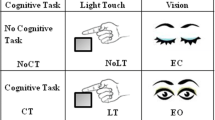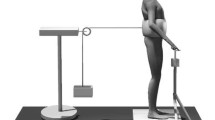Abstract
The purpose of the study was to investigate the individual and combined effects of applying light finger touch and performing a cognitive task on postural sway. Fourteen healthy young individuals stood on the force platform with light finger touch contact applied to an external stable structure and without finger touch. Both tasks were performed with and without a cognitive task (counting backward from a randomly chosen three-digit number). The center of pressure excursion and velocity as well as sway area were calculated. Participants demonstrated significantly smaller postural sway in the presence of a finger touch contact (p < 0.05), while postural sway was increased during the performance of the cognitive task (p < 0.05). When two tasks were performed simultaneously, body sway increased as compared to standing with light touch only (p < 0.05) and decreased when compared to standing and performing the cognitive task only (p < 0.05). This suggests that a positive effect of finger touch on body sway could be diminished by the simultaneous performance of a cognitive task. The outcome provides a foundation for future studies of the individual and combined effects of light finger touch and cognitive tasks on postural control.




Similar content being viewed by others
References
Andersson G, Hagman J, Talianzadeh R, Svedberg A, Larsen HC (2002) Effect of cognitive load on postural control. Brain Res Bull 58:135–139
Bellebaum C, Daum I (2007) Cerebellar involvement in executive control. Cerebellum 6:184–192
Beuter A, Hernandez R, Rigal R, Modolo J, Blanchet PJ (2008) Postural sway and effect of levodopa in early Parkinson’s disease. Can J Neurol Sci 35:65–68
Boisgontier MP, Beets IA, Duysens J, Nieuwboer A, Krampe RT, Swinnen SP (2013) Age-related differences in attentional cost associated with postural dual tasks: increased recruitment of generic cognitive resources in older adults. Neurosci Biobehav Rev 37:1824–1837
Borg GA (1982) Psychophysical bases of perceived exertion. Med Sci Sports Exerc 14:377–381
Burgess PW (2000) Strategy application disorder: the role of the frontal lobes in human multitasking. Psychol Res 63:279–288
Casteran M, Putot A, Pfitzenmeyer F, Thomas E, Manckoundia P (2016) Analysis of the impact of a cognitive task on the posture of elderly subjects with depression compared with healthy elderly subjects. Clin Neurophysiol 127:3406–3411
Ceyte H, Lion A, Caudron S, Kriem B, Perrin PP, Gauchard GC (2014) Does calculating impair postural stabilization allowed by visual cues? Exp Brain Res 232:2221–2228
Chen B, Aruin AS (2013) Does the type of somatosensory information from the contralateral finger touch affect grip force control while lifting an object? Neurosci Lett 556:196–199
Clapp S, Wing AM (1999) Light touch contribution to balance in normal bipedal stance. Exp Brain Res 125:521–524
Cunha BP, Alouche SR, Araujo IM, Freitas SM (2012) Individuals with post-stroke hemiparesis are able to use additional sensory information to reduce postural sway. Neurosci Lett 513:6–11
Dickstein R, Shupert CL, Horak FB (2001) Fingertip touch improves postural stability in patients with peripheral neuropathy. Gait Posture 14:238–247
Fiez JA, Petersen SE, Cheney MK, Raichle ME (1992) Impaired non-motor learning and error detection associated with cerebellar damage. A single case study. Brain 115 Pt 1:155–178
Ghai S, Ghai I, Effenberg AO (2017) Effects of dual tasks and dual-task training on postural stability: a systematic review and meta-analysis. Clin Interv Aging 12:557–577
Holden M, Ventura J, Lackner JR (1994) Stabilization of posture by precision contact of the index finger. J Vestib Res 4:285–301
Horak FB, Diener HC (1994) Cerebellar control of postural scaling and central set in stance. J Neurophysiol 72:479–493
Huxhold O, Li SC, Schmiedek F, Lindenberger U (2006) Dual-tasking postural control: aging and the effects of cognitive demand in conjunction with focus of attention. Brain Res Bull 69:294–305
Iyengar V, Santos MJ, Ko M, Aruin AS (2009) Effect of contralateral finger touch on grip force control in individuals with multiple sclerosis. Clin Neurophysiol 120:626–631
Jeka JJ (1997) Light touch contact as a balance aid. Phys Ther 77:476–487
Jeka JJ, Lackner JR (1994) Fingertip contact influences human postural control. Exp Brain Res 100:495–502
Jeka JJ, Lackner JR (1995) The role of haptic cues from rough and slippery surfaces in human postural control. Exp Brain Res 103:267–276
Jeka JJ, Easton RD, Bentzen BL, Lackner JR (1996) Haptic cues for orientation and postural control in sighted and blind individuals. Percept Psychophys 58:409–423
Kanekar N, Lee YJ, Aruin AS (2013) Effect of light finger touch in balance control of individuals with multiple sclerosis. Gait Posture 38:643–647
Lackner JR, DiZio P, Jeka J, Horak F, Krebs D, Rabin E (1999) Precision contact of the fingertip reduces postural sway of individuals with bilateral vestibular loss. Exp Brain Res 126:459–466
Laufer Y, Ashkenazi T, Josman N (2008) The effects of a concurrent cognitive task on the postural control of young children with and without developmental coordination disorder. Gait Posture 27:347–351
Manckoundia P, Pfitzenmeyer P, d’Athis P, Dubost V, Mourey F (2006) Impact of cognitive task on the posture of elderly subjects with Alzheimer’s disease compared to healthy elderly subjects. Mov Disord 21:236–241
Maylor EA, Allison S, Wing AM (2001) Effects of spatial and nonspatial cognitive activity on postural stability. Br J Psychol 92(Part 2):319–338
Montero-Odasso M, Bergman H, Phillips NA, Wong CH, Sourial N, Chertkow H (2009) Dual-tasking and gait in people with mild cognitive impairment. The effect of working memory. BMC Geriatr 9:41
Polskaia N, Richer N, Dionne E, Lajoie Y (2015) Continuous cognitive task promotes greater postural stability than an internal or external focus of attention. Gait Posture 41:454–458
Prado JM, Stoffregen TA, Duarte M (2007) Postural sway during dual tasks in young and elderly adults. Gerontology 53:274–281
Prieto TE, Myklebust JB, Hoffmann RG, Lovett EG, Myklebust BM (1996) Measures of postural steadiness: differences between healthy young and elderly adults. IEEE Trans Biomed Eng 43:956–966
Rabin E, Chen J, Muratori L, DiFrancisco-Donoghue J, Werner WG (2013) Haptic feedback from manual contact improves balance control in people with Parkinson’s disease. Gait Posture 38:373–379
Richer N, Saunders D, Polskaia N, Lajoie Y (2017) The effects of attentional focus and cognitive tasks on postural sway may be the result of automaticity. Gait Posture 54:45–49
Segev-Jacubovski O, Herman T, Yogev-Seligmann G, Mirelman A, Giladi N, Hausdorff JM (2011) The interplay between gait, falls and cognition: can cognitive therapy reduce fall risk? Expert Rev Neurother 11:1057–1075
Shumway-Cook A, Woollacott MH (2016) Motor control: translating research into clinical practice, 5th edn. Walters Kluwer, p 660
Stins JF, Roerdink M, Beek PJ (2011) To freeze or not to freeze? Affective and cognitive perturbations have markedly different effects on postural control. Hum Mov Sci 30:190–202
Suomi R, Koceja DM (1994) Postural sway patterns of normal men and women and men with mental retardation during a two-legged stance test. Arch Phys Med Rehabil 75:205–209
Tanaka H, Uetake T (2005) Characteristics of postural sway in older adults standing on a soft surface. J Hum Ergol (Tokyo) 34:35–40
Tremblay F, Mireault AC, Dessureault L, Manning H, Sveistrup H (2004) Postural stabilization from fingertip contact: I. Variations in sway attenuation, perceived stability and contact forces with aging. Exp Brain Res 157:275–285
Vuillerme N, Nougier V (2003) Effect of light finger touch on postural sway after lower-limb muscular fatigue. Arch Phys Med Rehabil 84:1560–1563
Winter DA, Prince F, Frank JS, Powell C, Zabjek KF (1996) Unified theory regarding A/P and M/L balance in quiet stance. J Neurophysiol 75:2334–2343
Woollacott M, Shumway-Cook A (2002) Attention and the control of posture and gait: a review of an emerging area of research. Gait Posture 16:1–14
Acknowledgements
We thank Etem Curuk for the help in recruiting subjects and data collection.
Author information
Authors and Affiliations
Corresponding author
Ethics declarations
Conflict of interest
The authors declare no potential conflicts of interest with respect to the authorship and/or publication of this article.
Rights and permissions
About this article
Cite this article
Lee, Y., Goyal, N. & Aruin, A.S. Effect of a cognitive task and light finger touch on standing balance in healthy adults. Exp Brain Res 236, 399–407 (2018). https://doi.org/10.1007/s00221-017-5135-9
Received:
Accepted:
Published:
Issue Date:
DOI: https://doi.org/10.1007/s00221-017-5135-9




